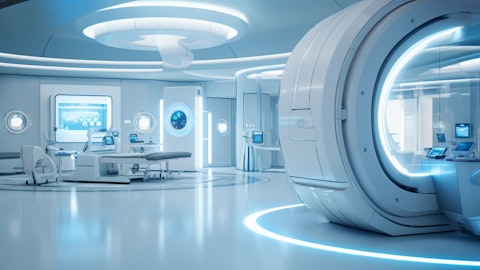Kevin Lobo: Yes. Thanks, Danielle. Look, we’ve always talked about outgrowing the market, let’s call it around numbers, 300 basis points ahead of the market. And in the past, there was time when hips weren’t quite growing that fast until we launched Insignia stem. But if you go back over the last decade, we have been growing roughly 300 basis points faster than market. So if the market moves up, then our numbers move up as well. And I think you’ve seen that all year, this year, as you’ve seen in the last couple of years. So that’s kind of the way I’d look at it is whatever the market grows, we should be roughly 300 basis points faster because we have this huge lead in robotic-assisted surgery, as well as cementless, and we just have a team that’s firing on all cylinders.
Operator: Our next question will come from Matt Miksic with Barclays. Your line is now open. Please go ahead.
Matt Miksic: Hey, everybody. Thanks so much. So maybe a couple of follow-ups, some of the things that have come up. But I’d love to try to get some additional color on M&A. You talked about sort of being back on OpEx, which is awesome. And just maybe if you could talk a little bit about what that means, large versus small, sort of new platform versus maybe something that strengthens one of your existing businesses, like, I don’t know, neurotech or ENT or neuromod has come up in the past or anything you could talk about that would be great. And then I have one follow-up.
Kevin Lobo: Yes. Hey, Matt. Look, I can’t get too specific with you, the nature of M&A. M&A is fluid and the deals have to make sense financially. You have to have the buyer that’s ready to sell when you want to acquire. I think because of the pent-up demand in the businesses, we have a lot of mouths to feed and they’re hungry. And so I would think in, let’s say, at least the first half of the year, it’ll probably be more of tucking things in that because we’ve been staying close to these companies and we have a bunch of deals that are teed up. But then once you get through the first half of the year, I think it becomes open field. And then open field means maybe more tuck ins, but it means maybe more things that are in the adjacency categories.
We’re always open to those, but a lot of things have to, stars have to align in order to be able to do those deals. But we’re back on the normal Stryker offense. And again, what does that mean? It means most of the deals by number are going to be those tuck-in deals, but things like Vocera and neurovascular and those types of Physio-Control, those kinds of deals are going to pop up that are more in the adjacent categories. But I can’t predict this honestly, because I don’t know what’s going to happen. But we are out hunting and we are excited to get back to a more regular M&A. It’s been a huge part of our offense. We know how to do this. We’ve gotten really good acumen around evaluations and around integrations, which early in my tenure, we weren’t so good at integrations.
And if I look at Wright Medical, it’s just been a role model for how to integrate a complex business, and the results have been stellar [ph].
Matt Miksic: That’s great. Thank you for that. And then just follow-up on ASCs. It’s always been a sort of hot topic, I guess, in the last few years, particularly coming out of the pandemic. So just maybe some thoughts, if you could, on where you are in terms of the build out of that opportunity. Maybe where like the percentage of hips and knees that are now you think being done through that channel and then sort of back to the M&A side of it. Is there other businesses that have some synergy there? You’ve obviously done well with equipment and with MAKO, with your OR equipment and implant pull through for these ASCs. But anything else makes sense to kind of bridge and lever that success you’ve had there? Thanks.
Kevin Lobo: Yes, thanks, Matt. Okay. I could spend a long time on this, but I’ll just sort of cut to the chase and say that, look, things are continuing to progress in the ASC. We’re now running between 12% to 15% of our hips and knees in the ASC. That’s higher, certainly, than it was last year. So it continues to climb at a gradual rate because the rate limiting factor is capacity and the buildouts of these ASCs, but it is definitely continuing a steady climb. We have everything we need for orthopedic ASCs, and when I say everything, I mean booms, lights, power tools, Steri-Shield, Neptune waste management, operating table, every implant from foot and ankle to shoulder to hips to knees to spine. And I’m going to include spine in that because we just most recently did a really terrific ASC deal in spine.
A lot of spine procedures are moving to the ASC. We did this in Duluth, Minnesota, which is a really exciting deal. And we were able to leverage spine in addition to a lot of other capital equipment in the ASC. And so those new builds and big renovations, we are absolutely beautifully positioned. What we’re now looking at, now that we’re a little bit in the GI space with Neptune and the POM acquisition that we have is, what else can we do in that space and other things we could add in that space. Now, I’m not saying that’s specifically about ASC. It’s about how we are. We like to be really busy in a call point, and now that we’re in the GI call point, what every call point we go into, we say, what else can we bring to that call point? What other value can we bring?
I’m not predicting that we’ll do something in that space, but that’s kind of how we look at it. But as it relates to the orthopedic ASC, we are in an incredibly good position to be able to win in the ASC market.
Operator: Our next question will come from Caitlin Cronin with Canaccord Genuity. Your line is now open. Please go ahead.
Caitlin Cronin: Hi. Thanks for taking the questions, and congrats on a great quarter. Just jumping up on Matt’s question earlier. Momentum in spine really seems to be strong. Do you have any more clarity on how much you’ve been able to capitalize on the disruption in the space or expect to kind of capitalize from the disruption?
Kevin Lobo: Yes, I tell you. Listen, our performance thus far has really nothing to do with the disruption of the consolidation. It’s just starting. We’ve just started to hear some disruption in Texas as an example and a couple of other little spots. So I would say very early days of disruption, and that’s not the reason why we’re doing better. We’ve kind of really improved our offense in spine, especially as it relates to enabling tech. I think the Q guidance was a big shot in the arm for the spine business. They’ve done a terrific job selling that and, of course, leveraging that for implants. That’s been more of a factor than disruption. I think we’re going to see the disruption starting this year, and hopefully we’ll be able to pick up on that. But thus far, there really hasn’t been much in the way of disruption, and we’re going to see that play out over the course of this year.




